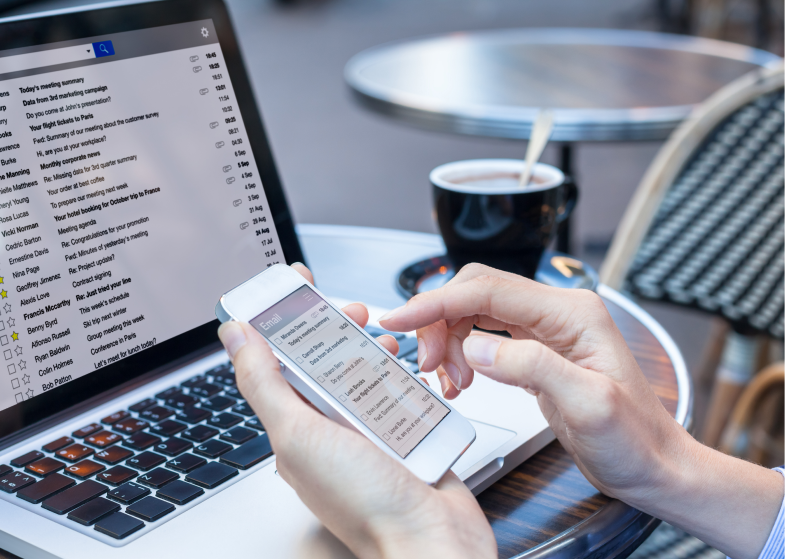When researcher Linda Stone realized she had the habit of holding her breath each time she opened her email inbox, she wondered if others did the same. After 6 months of observing nearly 200 others, she concluded she wasn’t alone. 80% of us experience a disruption in healthy breathing patterns when checking email, a phenomenon Stone coined ‘email apnea.’
Interrupted breathing leads to stress, anxiety, and myriad health problems. Could reducing stress at the office be as simple as remembering to breathe?
What Is Email Apnea?
Stone coined the term email apnea in 2008. Since others have confirmed her findings; we don’t breathe consistently when in front of a screen. Email apnea, otherwise known as screen apnea, can occur as we’re mindlessly scrolling, web browsing, or even texting.
What causes this interrupted breathing may be linked to distraction and the anxiety of anticipation. Each time we’re disturbed by the ping of a notification both our attention and our breathing are interrupted.
Breathing is something we do automatically. We don’t typically focus on each cycle of breath. And yet researchers are beginning to discover that modern distractions, particularly those involving screens, have the ability to interrupt even these autonomic processes.
Unfortunately, holding breath, shallow breathing, mouth breathing, or failure to fully exhale lead to negative health consequences for both body and mind.
Read more about the effects of anxiety on your health.
The Importance Of The Breath
Even brief interruptions to our breathing signal our central nervous system to turn on a stress response. Shallow or uneven breath triggers the release of cortisol, activates our fight or flight response, and sends our heart rate racing.
The temporary discomfort of stress may not seem like a big deal, but it leads to long-term health problems as breath-holding accumulates over time. Cumulative breath-holding potentially contributes to the same negative health consequences as sleep apnea.
Holding our breath or breathing shallowly creates a systemic imbalance which can lead to the following health problems:
- Compromised immune function
- Systemic inflammation
- Activation of the fight or flight stress response system
- Difficulty sleeping
- Reduced memory and learning function
- Elevated anxiety and depression
Conversely, when we breath consistently, deeply and evenly we experience the following benefits:
- Strengthened immune function
- Lowered heart rate and blood pressure
- Improved organ function
- Less chronic pain
- Increased energy
- Mitigated reaction to stress
- Reduced symptoms of anxiety and depression
Curing Email Apnea: Remember To Breathe
The benefits of mindfulness in the workplace are endless. Now, we can add mindful, consistent breathing to this list.
Read how a single mindful breath holds all benefits of mindfulness practice.
Before opening your email, set an intention to remain aware of your breathing. In addition, the following tips help improve breath awareness when in front of a screen.
- Limit Workplace Distractions: Breath-holding is triggered by distraction. Avoid distractions by silencing notifications. Cease multitasking and complete one thing at a time. (Check out this guide for replacing common distractions with focused work.)
- Set Email Boundaries: Avoid jumping in and out of your inbox, akin to mindlessly scrolling. Set clear boundaries regarding when you’ll open and respond to incoming messages.
- Establish Good Posture: An ergonomically designed workspace promotes healthy breathing by keeping your spine tall and neutrally aligned.
- Take Frequent Screen Breaks: Reduce the cumulative effects of screen apnea by spending less time in front of your screen. Take frequent breaks, outdoors if possible.
- Focus on the Exhale Breath: Anticipation triggers an inhale that’s not always followed by a full breath out. When we focus on exhaling for longer than we breathe in, our stress response is mitigated.
- Use Breathing Reminders: Hang an inspirational quote, nature photo, or reminder to breathe within sight of your screen. Take three deep, full breaths when switching from one task to another.
- Train in Breath Awareness: In Stone’s observational study, 20% did NOT have email apnea. These were musicians, athletes, dancers, and others well trained in breath awareness.
- Meditate Regularly: Meditation is another tool that improves mindfulness of breath. It also helps recognize when we’ve become distracted. To improve mindfulness of breath, try any of the following meditations below.
- Discover our free library of breathing meditations.
Breath interruption while emailing can increase stress and lead to long-term health consequences. The good news is, the solution to email apnea is a simple one and readily available to us all. With breath awareness, we can reduce email-related stress and achieve greater long-term health.








